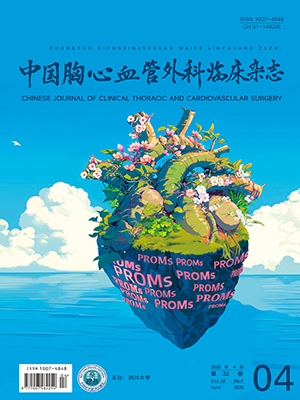Objective To investigate the expression of transcription factors including nuclear factor-κB (NF-κB) and activator protein-1 (AP-1) in vascular endothelial cells (ECs) in different flow fields, and provide experimental evidence for mechanical signal effects on gene regulation pattern of ECs. Methods Cultured human umbilical vein ECs were loaded into steady flow chambers of laminar flow or turbulent flow and observed at 6 time points (0.5 h, 1 h, 2 h, 3 h, 4 h and 5 h) based on different load time. Spacial and temporal characteristics of NF-κB and AP-1 expression in ECs in different flow chambers were detected at a protein level by laser confocal microscope. Results In laminar flow, NF-κB expression rose to peak at 1 hour (26.49±1.63, P<0.05)and then declined. In turbulent flow, NF-κB expression rose to peak at 3 hours (34.41±6.43, P<0.05). In laminar flow, c-Jun/AP-1 expression was transiently elevated, reached its peak at 0.5 hour (18.95±5.38,P<0.05)and then fell to its baseline level. In turbulent flow, c-Jun/AP-1 expression rose slowly but steady to peak(P<0.05) . Conclusion The effects of turbulent flow on NF-κB and AP-1 expression in ECs are different from those of laminar flow. Up-regulation and activation of NF-κB and AP-1 expression in ECs induced by turbulent flow may cause pathological changes in morphological structure and functional behavior of ECs.
Citation:
YANG Jiahuang,LIN Ke,MENG Wei,ZHANG Eryong.. Effect of Different Flow Fields on Nuclear Factor -κB and Activator Protein-1 Expression in Vascular Endothelial Cells. Chinese Journal of Clinical Thoracic and Cardiovascular Surgery, 2012, 19(5): 543-546. doi:
Copy
Copyright © the editorial department of Chinese Journal of Clinical Thoracic and Cardiovascular Surgery of West China Medical Publisher. All rights reserved
| 1. |
Chiu JJ, Chien S. Effects of disturbed flow on vascular endothelium:pathophysiological basis and clinical perspectives. Physiol Rev, 2011, 91 (1):327-387.
|
| 2. |
Poelmann RE, Gittenberger-de Groot AC, Hierck BP. The development of the heart and microcirculation:role of shear stress. Med Biol Eng Comput, 2008, 46 (5):479-484.
|
| 3. |
Gimbrone MA Jr, Topper JN, Nagel T, et al. Endothelial dysfunction, hemodynamic forces, and atherogenesis. Ann N Y Acad Sci, 2000, 902:230-239 .
|
| 4. |
LaMack JA, Himburg HA, Zhang J, et al. Endothelial gene expression in regeions of defined shear exposure in the porcine iliac arteries. Ann Biomed Eng, 2010, 38 (7):2252-2262.
|
| 5. |
Jaffe EA, Nachman RL, Becher CG, et al. Culture of human endothelial cells derived from umbilical veins. J Clin Invest, 1973, 52 (11):2745-2756.
|
| 6. |
Freed JK, Greene AS. Proteomic analysis of shear stress-mediated protection from TNF-alpha in endothelial cells. Microcirculation, 2010, 17 (4):259-270.
|
| 7. |
Shyy J Y, Chien S. Role of integrins in endothelial mechanosensing of shear stress. Circ Res, 2002, 91 (9):769-775.
|
| 8. |
Haddad O, Chotard-Ghodsnia R, Verdier C, et al. Tumor cell∕endothelial cell tight contact upregulates endothelial adhesion molecule expression mediated by NFkappaB:differential role of the shear stress. Exp Cell Res, 2010, 316 (4):615-626.
|
| 9. |
Boon RA, Horrevoets AJ. Key transcriptional regulators of the vasoprotective effects of shear stress. Hamostaseologie, 2009, 29 (1):39-40, 41-43.
|
| 10. |
Kakisis JD, Liapis CD, Sumpio BE. Effects of cyclic strain on vascular cells. Endothelium, 2004, 11 (1):17-28.
|
| 11. |
Nitzan R, Hava Y, Ayelet SS, et al. Fluid shear stress and the vascular endothelium:For better and for worse. Prog Biophys Mol Biol, 2003, 81 (3):177-199.
|
| 12. |
Castier Y, Ramkhelawon B, Riou S, et al. Role of NF-kappaB in flow-induced vascular remodeling. Antioxid Redox Signal, 2009, 11 (7):1641-1649.
|
| 13. |
Doroudi R, Gan LM, Selin Sjögren L, et al. Effects of shear stress on eicosanoid gene expression and metabolite production in vascular endothelium as studied in a novel biomechanical perfusion mode. Biochem Biophys Res Commun, 2000, 269 (1):257-264.
|
| 14. |
Gan L, Doroudi R, Hägg U, et al. Differential immediate-early gene responses to shear stress and intraluminal pressure in intact human conduit vessels. FEBS Lett, 2000, 477 (1-2):89 -94.
|
| 15. |
Siasos G, Tousoulis D, Siasou Z, et al. Shear stress, protein kinases and atherosclerosis. Curr Med Chem, 2007, 14 (14):1567-1572.
|
| 16. |
Warboys CM, Amini N, de Luca A, et al. The role of blood flow in determining the sites of atherosclerotic plaques. F1000 Med Rep, 2011, 3:5.
|
| 17. |
Nigro P, Abe JI, Berk B. Flow shear stress and atherosclerosis:a matter of site specificity. Antioxid Redox Signal, 2011, 15 (5):1405-1414.
|
- 1. Chiu JJ, Chien S. Effects of disturbed flow on vascular endothelium:pathophysiological basis and clinical perspectives. Physiol Rev, 2011, 91 (1):327-387.
- 2. Poelmann RE, Gittenberger-de Groot AC, Hierck BP. The development of the heart and microcirculation:role of shear stress. Med Biol Eng Comput, 2008, 46 (5):479-484.
- 3. Gimbrone MA Jr, Topper JN, Nagel T, et al. Endothelial dysfunction, hemodynamic forces, and atherogenesis. Ann N Y Acad Sci, 2000, 902:230-239 .
- 4. LaMack JA, Himburg HA, Zhang J, et al. Endothelial gene expression in regeions of defined shear exposure in the porcine iliac arteries. Ann Biomed Eng, 2010, 38 (7):2252-2262.
- 5. Jaffe EA, Nachman RL, Becher CG, et al. Culture of human endothelial cells derived from umbilical veins. J Clin Invest, 1973, 52 (11):2745-2756.
- 6. Freed JK, Greene AS. Proteomic analysis of shear stress-mediated protection from TNF-alpha in endothelial cells. Microcirculation, 2010, 17 (4):259-270.
- 7. Shyy J Y, Chien S. Role of integrins in endothelial mechanosensing of shear stress. Circ Res, 2002, 91 (9):769-775.
- 8. Haddad O, Chotard-Ghodsnia R, Verdier C, et al. Tumor cell∕endothelial cell tight contact upregulates endothelial adhesion molecule expression mediated by NFkappaB:differential role of the shear stress. Exp Cell Res, 2010, 316 (4):615-626.
- 9. Boon RA, Horrevoets AJ. Key transcriptional regulators of the vasoprotective effects of shear stress. Hamostaseologie, 2009, 29 (1):39-40, 41-43.
- 10. Kakisis JD, Liapis CD, Sumpio BE. Effects of cyclic strain on vascular cells. Endothelium, 2004, 11 (1):17-28.
- 11. Nitzan R, Hava Y, Ayelet SS, et al. Fluid shear stress and the vascular endothelium:For better and for worse. Prog Biophys Mol Biol, 2003, 81 (3):177-199.
- 12. Castier Y, Ramkhelawon B, Riou S, et al. Role of NF-kappaB in flow-induced vascular remodeling. Antioxid Redox Signal, 2009, 11 (7):1641-1649.
- 13. Doroudi R, Gan LM, Selin Sjögren L, et al. Effects of shear stress on eicosanoid gene expression and metabolite production in vascular endothelium as studied in a novel biomechanical perfusion mode. Biochem Biophys Res Commun, 2000, 269 (1):257-264.
- 14. Gan L, Doroudi R, Hägg U, et al. Differential immediate-early gene responses to shear stress and intraluminal pressure in intact human conduit vessels. FEBS Lett, 2000, 477 (1-2):89 -94.
- 15. Siasos G, Tousoulis D, Siasou Z, et al. Shear stress, protein kinases and atherosclerosis. Curr Med Chem, 2007, 14 (14):1567-1572.
- 16. Warboys CM, Amini N, de Luca A, et al. The role of blood flow in determining the sites of atherosclerotic plaques. F1000 Med Rep, 2011, 3:5.
- 17. Nigro P, Abe JI, Berk B. Flow shear stress and atherosclerosis:a matter of site specificity. Antioxid Redox Signal, 2011, 15 (5):1405-1414.




